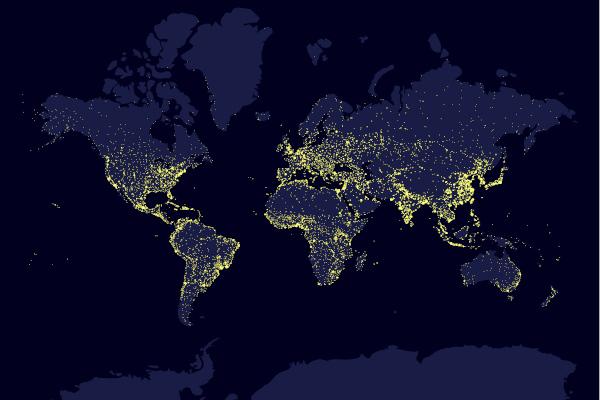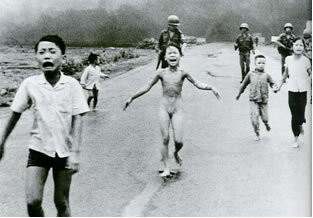THE world population reached the 1 billion mark in 1800. At the time, sanitary conditions were precarious compared to current ones, and this number was frightening, since pessimistic perspectives were created around the high number of inhabitants on the planet, like the theory of Thomas Malthus.
With the passage of time and scientific and technological developments, the world population continued to grow, reaching 7 billion in 2011 and, in 2020, 7.8 billion.
Read too: What is demographic transition?
world population growth
Since when we reached the mark of 1 billion inhabitants, in 1800, the pace of world population growth it has been expressive, especially in the last century. Since Industrial Revolution, in the eighteenth century, the inhabitants of the globe experienced significant changes, which allowed more longevity and better living conditions.

Examples of these significant changes are:
development of penicillin;
use of technology in food production;
emergence of vaccines to eradicate illnesses;
basic sanitation, sewage treatment and urban planning, in addition to infrastructure that enabled the world's population to live longer and better.
Since we became sedentary, during the Neolithic Revolution, our diet and lifestyle led us to live longer., without the dangers of nature experienced by our ancestors. However, even with a more comfortable life, the population did not increase significantly, as in many places food production could not meet everyone's needs, in addition to the existence of untreated diseases, such as the event of PThis one noegret in Medieval Europe.

Was with technological development and science that human beings have reached the level of living longer: vaccines, medicines, large-scale food production, among other innovations, which considerably reduced the mortality rate.
We reached 2 billion people in 1930, at the time of the proliferation of penicillin around the world and the development of vaccines. Fifty years later, in the 1980s, we were already more than twice as many people, 5 billion. At the beginning of the 21st century, in 2000, 6 billion. At the moment, are almost 8 billion of inhabitants. This growth is frightening, but it makes us reflect on the positive changes to human life, making it more comfortable than 12,000 years ago.
See too: What are demographic theories?
Distribution of world population
The world population is not evenly distributed across the globe. There are huge areas with demographic gaps, such as the African continent and South America. However, there are small territories that house a significant amount of people, making them live in overcrowded conditions in certain places.
As an example, let's look at the case of Japan, a small country in terms of land area, but home to more than 120 million people. China is another example: it is the country that has the largest population in the world, but this population is mostly concentrated in the eastern part of the country.
According to Worldometer, an organization that studies demographic data, the world's population is distributed across the planet as follows:
Continent |
Population |
Percentage in relation to the world population |
Asia |
4.641.054.775 |
59,5 % |
Africa |
1.340.598.147 |
17,2 % |
America |
1.022.831.978 |
13,1% |
Europe |
747.636.026 |
9,6 % |
Oceania |
42.677.813 |
0,5 % |
Ranking of the most populous countries in the world
Let's look at the 10 most populous countries in the world and their respective populations, with data from 2019.
10th place: Mexico — 127,575,529 inhabitants.
9th place: Russia — 145,872,260 inhabitants.
8th place: Bangladesh — 163,046,173 inhabitants.
7th place: Nigeria — 200,963,603 inhabitants.
6th place: Brazil — 211,049,519 inhabitants.
5th place: Pakistan — 216,565,317 inhabitants.
4th place: Indonesia — 270,625,567 inhabitants.
3rd place: USA — 326,766,748 inhabitants.
2º place: India — 1,366,417,756 inhabitants.
1st place: China — 1,433,783,692 inhabitants.
Populous countries vs. populated countries
The term populous refers to the absolute population of a place, that is, the total number of people who live there. China, for example, is the most populous country on the planet.

The term populated it turns to the way in which the absolute population is distributed across the territory, referring to what is known as relative population, which is measured by the index of dintensity demographic (the proportional relationship between the number of people and the area of the location). The most populated country in the world is monaco, with a demographic density of 26,152 inhab/km² and a population of 38,967 people
Do not stop now... There's more after the advertising ;)
Also access: What is the difference between absolute population and relative population?
population of Brazil
The Brazilian population is one of the most heterogeneous on the planet, with great ethnic diversity. It is also a population concentrated in the eastern part of the country, heritage of the historical colonization process, which always prioritized the Brazilian east. To corroborate, it is enough to note that the main Brazilian cities are located on the coast of the country.
The responsible for counting the population of Brazil is the Brazilian Institute of Geography and Statistics (IBGE), founded in 1937, during the government of Getúlio Vargas. However, historical records state that the first Brazilian census was taken in 1872, during the reign of D. Peter II.
To count the population, the IBGE conducts a census with the help of the National Household Sample Program (Pnad), which is carried out annually. The census with the total of Brazilians is updated every 10 years.
Pnad data are important for the development of public policies, in addition to helping us to know the national reality of the five regions of the country.
According to 2020 estimates, the Brazilian population was 211.8 million. The most populous municipality is Sao Paulo, with 12,325,232 inhabitants.
China's population
Considered the most populous country in the world, China saw its population increase considerably in the second half of the 20th century, which brought benefits to the country, such as a large supply of labor, attracting transnational companies from the 1970s, with the opening of the country to the capitalist economy, after the death of the leader Mao Tse-Tung.
However, the population explosion caused there to be a strict birth control, leading the government to implement the one-child policy in the 1980s, an unsuccessful attempt to reduce population growth. It was frustrated because, over the last few decades, there has been a sharp reduction in birth rates, an increase in life expectancy and a reduction in mortality, factors that, together, have led to a progressive population-ageing.
Thereby, in 2018 the Chinese government revoked this policy and improved birth incentive policies, such as increased maternity leave, both in time and in salary for Chinese women.
The largest population in the world carries with it enormous problems. Chinese cities are huge in terms of population size. This overloads the health and social security system, in addition to bringing to light the fragility of housing policies. There is also the weight of being a large industrial economy, which causes air pollution and reduced quality of life.
solved exercises
Question 1 - (UECE 2016) Note the following excerpt:
“Two hundred and fifty million inhabitants in Classical Antiquity, half a billion by the mid-seventeenth century, one billion in 1850, two billion in 1940, plus four billion before 1980. [...] The most unavoidable reason for inequality between men today is their geographical origin, that is, the place where they are born”.
George, 1986, p.7-8. In. Moreira, Ruy. Where does geographic thinking go? For a critical epistemology. Context, São Paulo, 2011. p.78-79.
Historical, social and spatial reflections on the distribution of man on Earth can be the most diverse. Among the causes of the demographic explosion, one can correctly point out
A) the hygiene revolution, which accompanied the Industrial Revolution, mainly in the areas of medicine and basic sanitation.
B) access for the entire world population to more modern and effective medicines and health care.
C) the global increase in food production, which eliminated hunger and malnutrition on all continents.
D) the increase in the number of cities in the world, a fact that drastically increased the global population.
Resolution
Alternative A. The population has grown considerably thanks to medical advances and improvements in basic sanitation, such as access to clean water and sewage treatment.
Question 2 - (IFBA 2017) Population geography corresponds to the historical constitution, distribution, dynamics and distribution of the globe's inhabitants. Knowing this complexity of factors and characteristics, the alternative that states that:
A) the distribution and social conditions of the population depend on the location and size of the countries, so that there is always a low population density in smaller countries.
B) the population structure in the world is characterized by the conflict between the growth in the number of elderly and the high birth rates, which are characteristic of the most developed countries in the worldwide.
C) neo-Malthusianism brings elements of Malthusian theory to justify economic inequality between countries and assign responsibility for the precarious or lagging development of countries to their rates of birth.
D) population theories seek to explain the relationship between population growth and social development, so that the Malthusian theory points to the real scarcity of food for the current population.
E) the population age structure tends to balance birth, young and adult population and longevity.
Resolution
Alternative C. The neo-Malthusian population theory attributes the misery and poverty of some countries to the high number of inhabitants, preaching drastic solutions, such as strict birth control, something controversial and that has no effect, as in the case of China, which abolished the one-child policy in 2018.
By Attila Matthias
Geography teacher


